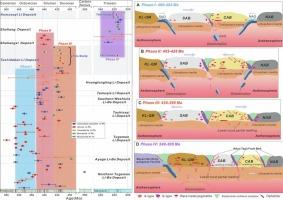中阿尔金塔什达班和Kumusayi Li矿床稀有金属伟晶岩年代学及多期岩浆成矿作用
IF 3.6
2区 地球科学
Q1 GEOLOGY
引用次数: 0
摘要
近年来的研究表明,造山带内伟晶岩及其伴生的稀有金属矿床的时空演化与造山带旋回的岩浆活动高峰密切相关。近年来,中国西北阿尔金塔格造山带新发现了许多稀有金属花岗质伟晶岩矿床,具有明显的多期伟晶岩侵位证据。为了约束该地区稀有金属伟晶岩的时间格局和构造背景,我们对塔什达班和Kumusayi伟晶岩型锂矿床的锆石、铌钽矿和独辉石进行了LA-ICP-MS U-Pb定年。塔什达班锆石和铌钽矿U-Pb年龄揭示了早奥陶世(448.3 ~ 440.2 Ma)和志留纪(424.6 ~ 415.6 Ma)两个阶段的锂成矿作用。晚三叠世较小岩浆期(215.4±1.5 Ma)。Kumusayi的铌钽矿(216.7±1.8 Ma)和独居石(205.3±0.8 Ma) U-Pb年龄限制了含矿伟晶岩位位在216.7 ~ 205.3 Ma之间。综合已有研究成果,提出阿尔金塔格造山带稀有金属伟晶岩的四期成矿模式:(1)486 ~ 454 Ma:造山带内微块(阿尔金塔格中部、阿尔金塔格北部和柴达木)的同步碰撞挤压导致地壳增厚和高压变质作用。脱水引发的下地壳变质沉积层序部分熔融作用,形成了具有初始Li-Cs-Ta富集的高分异花岗质熔体;(2)453 ~ 425 Ma:阿尔金中部、阿尔金北部和柴达木地块的最终合并可能导致地壳增厚和剪切,从而诱发大规模的花岗质岩浆活动。这可能在中阿尔金地区形成了稀有金属富熔体,为稀有金属伟晶岩的形成和主相成矿提供了有利条件;(3)425 - 385 Ma:过渡到碰撞后延伸。岩石圈发生了引力坍缩,地幔衍生的底板可能导致下地壳进一步部分熔融。这可能持续了岩浆上升和分馏。虽然熔体体积可能减少,但锂富集可能持续存在;(4)240 ~ 205 Ma:阿尔金断裂系统的再活化可能形成了岩石圈尺度的走滑剪切带,为岩浆上升和地壳熔融提供了通道。这进一步强调了主剪切带在稀有金属成矿中的关键作用。总的来说,本研究揭示了阿尔金塔格造山带稀有金属成矿的幕式性质,并提出了一个四阶段成矿模式,其中包括新发现的三叠纪锂辉岩伟晶岩侵位事件。这些发现为构造岩浆对Li-Cs-Ta (LCT)型伟晶岩形成的控制提供了新的认识,并突出了在长寿命造山带中进行稀有金属勘探的潜力。本文章由计算机程序翻译,如有差异,请以英文原文为准。

Geochronology and multiphase magmatic-mineralization of rare-metal pegmatites at the Tashidaban and Kumusayi Li deposits, Central Altyn Tagh Orogen, NW China
Recent research indicates that the spatiotemporal evolution of pegmatites within orogenic belts and their associated rare-metal deposits was closely linked to the peaks of magmatic activity across orogenic cycles. In recent years, many rare-metal granitic pegmatite deposits have been newly discovered in the Altyn Tagh Orogen of northwestern China, exhibiting clear evidence of multiphase pegmatite emplacement. To constrain the temporal framework and tectonic setting of rare-metal pegmatites in this region, we conduct LA-ICP-MS U-Pb dating of zircon, columbite–tantalite, and monazite from the Tashidaban and Kumusayi pegmatite-hosted Li deposits. Zircon and columbite-tantalite U-Pb ages from Tashidaban reveal two stages of Li mineralization in the Early Ordovician (448.3 – 440.2 Ma) and the Silurian (424.6 – 415.6 Ma). A minor Late Triassic magmatic phase was also identified (215.4 ± 1.5 Ma). U-Pb ages on columbite-tantalite (216.7 ± 1.8 Ma) and monazite (205.3 ± 0.8 Ma) from Kumusayi constrain the ore-bearing pegmatite emplacement to 216.7 – 205.3 Ma.
Integrating published studies, we propose a four-phase ore-forming model for rare-metal pegmatites in the Altyn Tagh Orogen: (1)486 – 454 Ma: syn-collisional compression among intra-orogenic microblocks (Central Altyn Tagh, Northern Altyn Tagh, and Qaidam) led to crustal thickening and high-pressure metamorphism. Dehydration-triggered partial melting of lower crustal metasedimentary sequences, which generated highly differentiated granitic melts with initial Li-Cs-Ta enrichment; (2)453 – 425 Ma: the final amalgamation of the Central Altyn Tagh, Northern Altyn Tagh, and Qaidam blocks may have caused crustal thickening and shearing, which induced large-scale granitic magmatism. This likely generated rare-metal fertile melts in the Central Altyn region, providing favorable conditions for rare-metal pegmatite formation and main-phase mineralization; (3)425 – 385 Ma: Transition to post-collisional extension. Lithospheric gravitational collapse occurred, and mantle-derived underplating likely induced further partial melting in the lower crust. This likely sustained magma ascent and fractionation. Although the melt volume may have decreased, Li enrichment likely persisted; (4)240 – 205 Ma: Reactivation of the Altyn Tagh fault system may have formed lithosphere-scale strike-slip and shear zones, which provided pathways for magma ascent and crustal melting. This further emphasizes the key role of major shear zones in rare-metal mineralization.
Collectively, this study reveals the episodic nature of rare-metal mineralization in the Altyn Tagh Orogen and proposes a four-stage metallogenic model, including a newly identified Triassic spodumene pegmatite emplacement event. These findings provide new insights into the tectono-magmatic controls on Li-Cs-Ta (LCT)-type pegmatite formation and highlight the potential for rare-metal exploration in long-lived orogenic systems.
求助全文
通过发布文献求助,成功后即可免费获取论文全文。
去求助
来源期刊

Ore Geology Reviews
地学-地质学
CiteScore
6.50
自引率
27.30%
发文量
546
审稿时长
22.9 weeks
期刊介绍:
Ore Geology Reviews aims to familiarize all earth scientists with recent advances in a number of interconnected disciplines related to the study of, and search for, ore deposits. The reviews range from brief to longer contributions, but the journal preferentially publishes manuscripts that fill the niche between the commonly shorter journal articles and the comprehensive book coverages, and thus has a special appeal to many authors and readers.
 求助内容:
求助内容: 应助结果提醒方式:
应助结果提醒方式:


